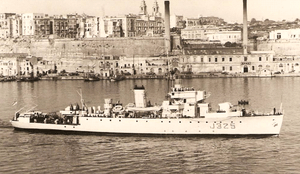HMS Providence (J325)
HMS Providence was a reciprocating engine-powered Algerine-class minesweeper built for the Royal Navy during the Second World War. She survived the war and was scrapped in 1958.
 The ship in Valetta 1946 | |
| History | |
|---|---|
| Name: | HMS Providence |
| Builder: | Redfern Construction Ltd, Toronto |
| Laid down: | 17 July 1943 |
| Launched: | 27 October 1943 |
| Commissioned: | 15 May 1944 |
| Renamed: |
|
| Identification: | Pennant number J325 |
| Fate: | Scrapped from 17 May 1958 |
| General characteristics | |
| Class and type: | Algerine-class minesweeper |
| Displacement: |
|
| Length: | 225 ft (69 m) o/a |
| Beam: | 35 ft 6 in (10.82 m) |
| Draught: | 12.25 ft 6 in (3.89 m) |
| Installed power: |
|
| Propulsion: |
|
| Speed: | 16.5 knots (30.6 km/h; 19.0 mph) |
| Range: | 5,000 nmi (9,300 km; 5,800 mi) at 10 knots (19 km/h; 12 mph) |
| Complement: | 85 |
| Armament: |
|
Design and description
The reciprocating group displaced 1,010–1,030 long tons (1,030–1,050 t) at standard load and 1,305–1,325 long tons (1,326–1,346 t) at deep load The ships measured 225 feet (68.6 m) long overall with a beam of 35 feet 6 inches (10.8 m). They had a draught of 12 feet 3 inches (3.7 m). The ships' complement consisted of 85 officers and ratings.[1]
The reciprocating ships had two vertical triple-expansion steam engines, each driving one shaft, using steam provided by two Admiralty three-drum boilers. The engines produced a total of 2,400 indicated horsepower (1,800 kW) and gave a maximum speed of 16.5 knots (30.6 km/h; 19.0 mph). They carried a maximum of 660 long tons (671 t) of fuel oil that gave them a range of 5,000 nautical miles (9,300 km; 5,800 mi) at 10 knots (19 km/h; 12 mph).[1]
The Algerine class was armed with a QF 4 in (102 mm) Mk V anti-aircraft gun[2] and four twin-gun mounts for Oerlikon 20 mm cannon. The latter guns were in short supply when the first ships were being completed and they often got a proportion of single mounts. By 1944, single-barrel Bofors 40 mm mounts began replacing the twin 20 mm mounts on a one for one basis. All of the ships were fitted for four throwers and two rails for depth charges.[1]
Construction and career
Providence was ordered as HMCS Forrest Hill in 1942, and laid down at the Toronto yards of Redfern Construction Ltd on 17 July 1943. She was renamed Providence in June 1943, and was launched on 27 October 1943.[3] Her conversion to a minesweeper was completed on 15 May 1944.[4] She served during the last years of the Second World War.
After the war, Providence participated in the Palestine Patrol. On 1 November 1946, she escorted the listing merchant vessel SS San Dimitrio, full of Jewish refugees, into Haifa.[5] On 10 December, Providence participated in the rescue of more refugees from the shipwrecked SS Athina, which had grounded in Syrna.[6]
Providence was subsequently sold for scrapping, and arrived at the yards of Young, of Sunderland on 17 May 1958.[7]
References
- Lenton, p. 261
- Chesneau, p. 65
- "HMS Providence (J325) - Válečné lodě 1900-1950". Archived from the original on 20 July 2011. Retrieved 9 August 2008.
- "Algerine Class". Retrieved 9 August 2008.
- Stewart, Ninian (2002). The Royal Navy and the Palestine Patrol. Routledge. p. 79. ISBN 0-7146-5210-5.
- "HMS Providence". Retrieved 9 August 2008.
- "Ex Canadian US Algerina Class". Retrieved 9 August 2008.
Bibliography
- Chesneau, Roger, ed. (1980). Conway's All the World's Fighting Ships 1922–1946. Greenwich, UK: Conway Maritime Press. ISBN 0-85177-146-7.
- Colledge, J. J.; Warlow, Ben (2006) [1969]. Ships of the Royal Navy: The Complete Record of all Fighting Ships of the Royal Navy (Rev. ed.). London: Chatham Publishing. ISBN 978-1-86176-281-8.
- Lenton, H. T. (1998). British & Empire Warships of the Second World War. Annapolis, Maryland: Naval Institute Press. ISBN 1-55750-048-7.